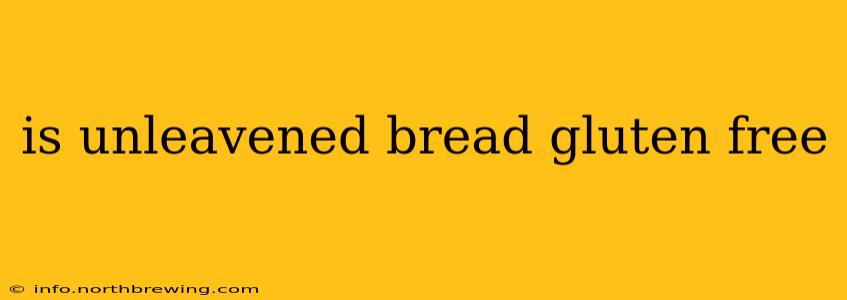The simple answer is: not necessarily. While unleavened bread can be gluten-free, it's not automatically so. The key lies in the ingredients used. Let's break down why.
What is Unleavened Bread?
Unleavened bread is bread made without any leavening agents, such as yeast, baking powder, or baking soda. This means it doesn't rise during baking. Historically, unleavened bread has been a staple in many cultures, often made with simple ingredients like flour and water. The texture tends to be flat and dense.
Why Some Unleavened Bread Contains Gluten
The most common type of flour used in making bread, including unleavened bread, is wheat flour. Wheat flour contains gluten, a protein that gives bread its elasticity and chewy texture. Therefore, unleavened bread made with wheat flour is not gluten-free.
What Makes Unleavened Bread Gluten-Free?
To make gluten-free unleavened bread, you need to use a gluten-free flour blend. Popular options include:
- Rice flour: Provides a slightly sweet, delicate flavor.
- Corn flour: Offers a slightly crumbly texture.
- Almond flour: Adds a nutty flavor and moist texture.
- Cassava flour: Creates a light and fluffy texture.
- Potato flour: Contributes to a soft and slightly starchy texture.
- Sorghum flour: Provides a slightly sweet and slightly grainy texture.
- Buckwheat flour: Note that while it's gluten-free, it is not actually a wheat-based grain. It has a distinct flavor and texture.
- Many commercial gluten-free flour blends: These blends usually combine several gluten-free flours to achieve a more versatile texture and flavor profile.
Many gluten-free baking recipes utilize a combination of these flours to achieve the desired texture and flavor.
How to Identify Gluten-Free Unleavened Bread
Always check the ingredient list carefully. Look for phrases like:
- "Gluten-free" explicitly stated on the packaging.
- Specific gluten-free flours listed as ingredients (like rice flour, almond flour, etc.).
- Absence of wheat flour, barley flour, or rye flour.
If the ingredients aren't clearly labeled as gluten-free, it's best to err on the side of caution and avoid it if you have celiac disease or a gluten intolerance.
Can I make gluten-free unleavened bread at home?
Absolutely! Many recipes are readily available online for gluten-free unleavened bread using various gluten-free flour blends. Experimenting with different flour combinations allows you to discover your preferred texture and flavor. Remember that the ratio of liquids and gluten-free flour needs careful adjustment compared to recipes utilizing wheat flour to achieve a good consistency.
What are the nutritional differences between gluten-free and wheat-based unleavened bread?
Gluten-free unleavened bread typically contains fewer calories and carbohydrates than wheat-based varieties, but the specific nutritional information varies greatly depending on the types of flours used. Some gluten-free options might be higher in fat or fiber compared to wheat-based versions. Always check the nutrition label for accurate information on a specific product.
Are there any common mistakes to avoid when making gluten-free unleavened bread?
One common mistake is not using enough binding agents in the recipe. Gluten-free flours often don't bind as well as wheat flour, so ingredients like xanthan gum or psyllium husk can help improve the texture and prevent the bread from crumbling. Another common mistake is using too much liquid. This can lead to a gummy or sticky consistency. Carefully follow the recipe and pay attention to the consistency of the dough to prevent these issues.
By understanding the ingredients and checking labels diligently, you can confidently choose unleavened bread that meets your dietary needs. Remember, always prioritize checking the ingredient list to ensure it aligns with your dietary requirements.
